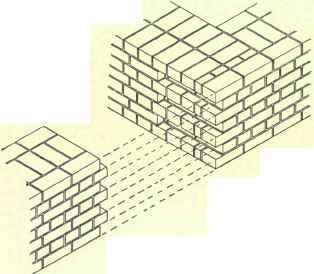Bricklaying. Part 4
Description
This section is from the book "Modern Buildings, Their Planning, Construction And Equipment Vol1", by G. A. T. Middleton. Also available from Amazon: Modern Buildings.
Bricklaying. Part 4

Fig. 194.
Whenever new work is bonded into old work the former should be built in cement mortar, to reduce the settlement to a minimum. As all buildings settle to a certain extent, it is better to connect new work to old by means of a chase cut into the old wall, so that the new work may settle independently of the old, as explained in Chapter I.
When old walls have to be broken away, or cut through for the insertion of doors or windows, the operation is performed by means of a brick axe (Fig. 174), the edges of the openings being trimmed with a cold chisel and hammer.
Broken Bond
-When the distance between two "corners" or portions first built does not permit the wall between them to be built entirely of whole bricks the bond will be broken at some point between the corners, bats of odd lengths being built into the wall, as shown shaded in Figs. 191 to 193.

Fig. 195.
Ornamental Brickwork
Ornamental features are frequently constructed in gauged brickwork. The pilaster with its pedestal and cornice, shown in Fig. 196, has been chosen for the purpose of illustrating the general principles of cutting and bonding.
Joints
The general arrangement of the joints should, for appearance sake, be as symmetrical as possible.
Entasis
The width of the pilaster is diminished towards the top, the return sides following a slight curve. This curve or Entasis, as it is called, is formed by first cutting the bricks to a rebate with all the faces square, the depth of the rebate increasing as the column diminishes in width. The bricks are built up with the side of the pilaster formed into a series of steps as shown at K, and the steps are rubbed off with a piece of brick or stone until the side forms the desired curve. At K the curve of the entasis is made exaggerated, so as to show the bricks stepped appreciably, but on referring to the elevation of the pilaster it will be seen that the curve, and consequently the amount of rubbing required, is very slight.
Mouldings
The mouldings are all formed in lengthening boxes with the sides cut to the desired sections, as already explained. Mitres, both internal and external, should be cut out of the solid, and not formed of two bricks mitred together. If it is not possible to cut a mitre out of one brick, two pieces should be joined together in the following manner: Shake a strong solution of shellac in methylated spirit, and then pour the solution into water and stir it violently. This causes the shellac to curdle, and the curds are taken and spread upon the two surfaces of the bricks which it is required to unite. The bricks are then pressed together and left for the shellac to harden, when they may be cut with no fear of fracture across the joint. The projections of the mouldings is considerably restricted by the sizes of the bricks, no course projecting more than 2 1/2 inches beyond the course below. If possible all projecting courses should be headers, so as to tail well into the wall, and the upper members of a cornice should be built in cement.
Dentils
The joints in the dentil courses should be arranged to occur immediately at the side of dentils, as they are very unsightly on their face, or on the face of the sinkings between them.
Dentils are cut in boxes similar to reducing boxes, with the side cut to the shape of the plan of the dentils. When a dentil course breaks round a projection a dentil may be arranged to come at the angle and appear on both faces, or two dentils, one on each face, may be arranged to intersect at the angle, as shown in Fig. 196. If dentils have to be cut out of small pieces they should be jointed with shellac on to one of the adjoining bricks.
Bonding
As every course of the pilaster, pedestal, and cornice is different on plan, the bonding of the bricks must be specially arranged, as shown by the plans A to J, Fig. 196.
Carved Brickwork is usually executed upon gauged work, the bricks being left projecting from the face of the wall to an extent just sufficient to include all the desired carving. In cutting the bricks which are to be carved the labour of "facing" is entirely unnecessary.
Continue to:


